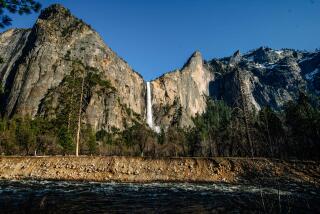Death Valley ‘Forty-Niner’s Chest’ a Hoax, Park Service Says
- Share via
The National Park Service has concluded that a small chest touted as a dramatic discovery of 150-year-old Death Valley artifacts is filled with a hodgepodge of items dating into the 20th century.
“The whole thing apparently was a hoax,” said Tim Stone, public information officer for Death Valley National Park.
The chest was turned over to the park service earlier this month by Jerry Freeman, an amateur archeologist from Pearblossom, who said he found it hidden in a small cave in a remote, mountainous part of the park.
Freeman insisted that the trunk had been left there by William Robinson, one of the gold seekers who took an ill-advised shortcut across Death Valley in 1849.
Inside the wooden chest was a manifest with Robinson’s name on it, along with a poignant letter of goodbyes scribbled by someone apparently facing death. There were gold and silver coins, a pistol, bowls, pieces of lace and a girl’s doll--all purportedly abandoned by Robinson when his last ox died and he trudged on alone.
But several days of examination, testing and consultation by a park service conservator from Tucson turned up a number of things that clearly had nothing to do with the forty-niners.
Glue on three items contained 20th century polymers. Two photos in the chest were tintypes--which required a photographic process that was not patented until 1856. A manufacturer’s stamp on the bottom of one of the bowls dated from at least as late as 1914.
Pieces of leather had been recently treated and were far too supple to have been drying in Death Valley heat for a century and a half, Stone said. Bits of adhesive from a price sticker were found on the bottom of another bowl.
There were several inconsistencies as well. A basket was dirty and laced with cobwebs while other items were extremely clean. The chest lock was rusty, but the latch wasn’t.
Freeman, who has been fascinated by the Death Valley forty-niners and retraced their path on foot, said he still believes that the chest was Robinson’s--he just doesn’t have the expertise to prove it.
“I will go to my grave believing William Robinson left his things in the desert so long ago. But my reputation as an archeologist and Death Valley historian is in ruins,” Freeman said in a statement he prepared after the park service informed him of its findings Wednesday afternoon.
Freeman says he found the chest in late November in the Panamint Mountains while scouting what he believes is the path the forty-niners took out of the valley.
He later told an Antelope Valley newspaper about the find. When park service staff read about it, they called him, and Freeman turned the chest over Jan. 5.
As publicity spread, Freeman got national media attention. The park staff, meanwhile, called in an expert from the Western Archeological and Conservation Center in Tucson to help determine if the chest was authentic.
The conservator arrived last Thursday, examined the chest, took some samples back to Arizona for testing and consulted the Smithsonian Institution in Washington.
Her conclusions, Stone said, didn’t surprise park staff.
“This just confirmed what many people believe. I think there was a lot of excitement before we saw the trunk and then [when we saw it] a feeling of ‘It’s too good to be true.’ Everything was in very good condition.”
Park Supt. Richard Martin has not decided whether the matter will be further investigated, Stone added.
More to Read
Sign up for Essential California
The most important California stories and recommendations in your inbox every morning.
You may occasionally receive promotional content from the Los Angeles Times.














